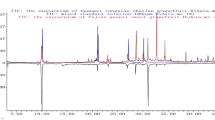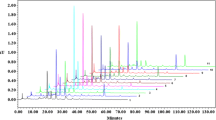Abstract
A novel, efficient, and accurate fingerprinting method using high performance liquid chromatography–photodiode array detection has been developed and optimized for the investigation and demonstration of the variance in chemical properties among Siraitia grosvenorii fruits from different origins. The effects of growth stages, cultivated varieties, collection locations, and fruit portions of the herb on chromatographic fingerprints were examined. Eleven compounds were identified on chromatograms by comparing the retention time and UV spectrum of each peak separately with those of external references. The results revealed that chromatographic fingerprints, combining similarity or hierarchical clustering analysis along with reference compounds, could efficiently identify and distinguish S. grosvenorii fruits from different sources, which provided helpful clues for studying the plants’ secondary metabolites and benefitted quality control.





Similar content being viewed by others
References
Pharmacopoeia of the Peoples Republic of China, part I (2005) Chemical Industry Publishing Press, Beijing, pp 147–148
Takemoto T, Arihara S, Nakajima T, Okuhira M (1983) Studies on the constituents of fructus Momordicae I–III. On the sweet principle, structure of sapogenin, structure of mogrosides. Yakugaku Zasshi 103:1151–1173
Matsumoto K, Kasai R, Ohtani K, Tanaka O (1990) Minor cucurbitane glycosides from fruits of Siraitia grosvenorii (cucurbitaceae). Chem Pharm Bull 38:2030–2032
Chang Q, Chen DH, Si JY, Shen LG (1994) The studies on the NMR spectra of mogrosides V. Chin J Mag Res 11:43–48
Si JY, Chen DH, Shen LG (1996) Isolation and determination of cucurbitane-glycosides from fresh fruits of Siraitia grosvenorii. Acta Bot Sin 38:489–494
Ukiya M, Akihisa T, Tokuda H, Toriumi M, Mukainaka T, Banno N, Kimura Y, Hasegawa J, Nishino H (2002) Inhibitory effects of cucurbitane glycosides and other triterpenoids from the fruit of Momordica grosvenori on Epstein–Barr virus early antigen induced by tumor promoter 12-O-tetradecanoylphorbol-13-acetate. J Agric Food Chem 50:6710–6715
Zhang JY, Yang XW (2003) Assignment of 1H- and 13C-NMR signals of mogroside IVa. Chin Pharm Sci 12:196–200
Li DP, Ikeda T, Matsuoka N, Nohara T, Zhang HR, Sakamoto T, Nonaka G (2006) Cucurbitane glycosides from unripe fruits of Lo Han Kuo (Siraitia grosvenorii). Chem Pharm Bull 54:1425–1428
Li DP, Ikeda T, Nohara T, Liu JL, Wen YX, Sakamoto T, Nonaka G (2007) Cucurbitane glycosides from unripe fruits of Siraitia grosvenorii. Chem Pharm Bull 55:1082–1086
Shi H, Hiramatsu M, Komatsu M, Kayama T (1996) Antioxidant property of fructus momordicae extract. Biochem Mol Biol Int 40:1111–1121
Takasaki M, Konoshima T, Murata Y, Sugiura M, Nishino H, Tokuda H, Matsumoto K, Kasai R, Yamasaki K (2003) Anticarcinogenic activity of natural sweeteners, cucurbitane glycosides, from Momordica grosvenorii. Cancer Lett 198:37–42
Takeo E, Yoshida H, Tada N, Murata Y, Yoshikawa S, Ishikawa T, Nakamura H, Ohsuzu F, Kohda H (2002) Sweet elements of Siraitia grosvenorii inhibit oxidative modification of low-density lipoprotein. J Atheroscler Thromb 9:114–120
Li HB, Zhang M, Wang Y, Guo BJ, Li L (2006) Colorimetric determination of triterpenoid saponin in Luohanguo. Food Sci 276:171–173
Chen C, Zhang H, Xiao W, Yong ZP, Bai N (2007) High-performance liquid chromatographic fingerprint analysis for different origins of sea buckthorn berries. J Chromatogr A 1154:250–259
Liu AH, Lin YH, Yang M, Guo H, Guan SH, Sun JH, Guo DA (2007) Development of the fingerprints for the quality of the roots of Salvia miltiorrhiza and its related preparations by HPLC-DAD and LC-MSn. J Chromatogr B 846:32–41
Lu FL, Li DP, Liu JL, Huang YL (2009) Chromatographic fingerprinting analysis on chemical compositions of Siraitia grosvenorii fruit with different drying treatments. Guangxi Agric Sci 40:625–628
Acknowledgment
This work was financial supported by a project of the Technology Foundation of Guilin (20070304-2). The project was also supported by West Light Doctoral Foundation of The Chinese Academy of Sciences. The authors would like to acknowledge Mr. Shuiyuan Jiang for his friendly help in collecting S. grosvenorii samples.
Author information
Authors and Affiliations
Corresponding author
Rights and permissions
About this article
Cite this article
Lu, F., Li, D., Fu, C. et al. Studies on chemical fingerprints of Siraitia grosvenorii fruits (Luo Han Guo) by HPLC. J Nat Med 66, 70–76 (2012). https://doi.org/10.1007/s11418-011-0555-5
Received:
Accepted:
Published:
Issue Date:
DOI: https://doi.org/10.1007/s11418-011-0555-5




